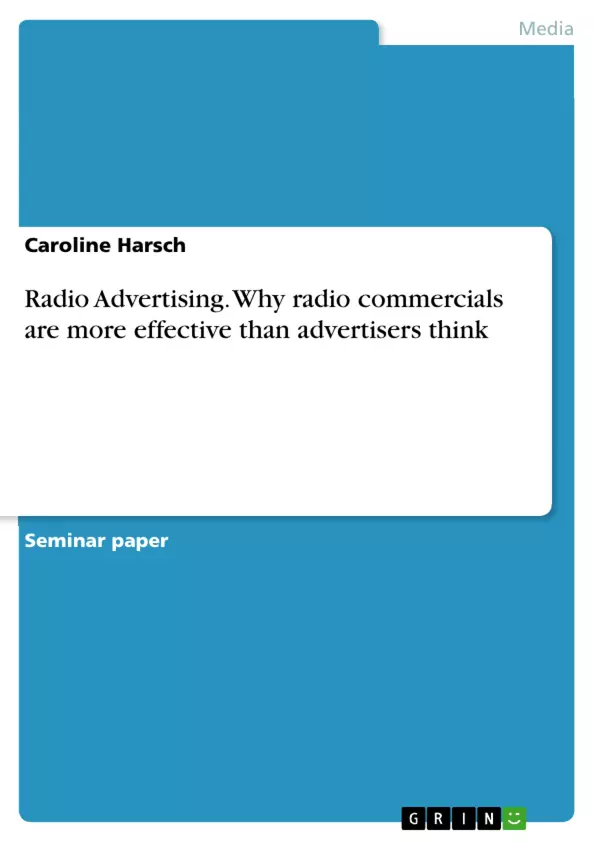Since people started to invent and sell products to others, advertising became more and more important as the diversity of products and brands grew. Advertisers use many different ways to convince their target audience to buy the product e.g. the wide variety of media such as TV, radio, Print or Internet.
The first media used for advertising as we know it today were printed media such as bills, newspapers and magazines. As those media only attracted the eye of people, everybody was thrilled by the possibility the new invention radio offered: Advertisers were able to reach their target audience through their ears. Today radio doesn’t seem to be that startling anymore compared to inventions like TV or Internet. They both combine seeing and hearing and the Internet also allows users to become active themselves. Due to the widespread meaning that advertising is more effective reaching the eye of clients than only their ear, radio is used the least as an advertising medium. The opportunities radio offers, because it’s only made for the ear aren’t seen by advertisers and companies and over the years radio became the “Stiefkind der Werbung” (Goldhammer, 1998, p. 17).
The little usage of radio as an advertising media is not adequate compared to the position it has for people, because in Germany is a nearly full supply of radios and most of the house-holds even own more than one radio. Because of that drawback the present essay focuses on the question why radio should be used more as an advertising media by pointing out the advantages it offers to advertisers, whereupon some pros only can be given by radio and not by any other media.
For some background information the essay gives a short summary of the history of radio ad-vertising (chapter 2). Chapter 3 makes the difference between the usage of radio by publics and by advertisers clear. After that analysis chapter 4.1 describes some more advantages radio offers as an advertising medium besides the results of the Media-Analysis. On the basis of all those chapters some hints for a good commercial are given in chapter 4.2. Chapter 5 is about the effect radio commercials have on listeners. At first it’s explained how radio commercials are processed by the human brain, while chapter 5.2 to 5.4 interpret a research for the company DasÖrtliche to explain how radio Mono-Campaigns, strategies with a mixture between radio and TV, and campaigns with three different media work.
Table of Contents
- Introduction
- History of radio advertising
- The usage of radio
- How radio is used by people
- How radio is used by advertisers
- Radio commercials
- Advantages of radio advertising
- Hints for a good radio commercial
- The effect of radio advertising
- Implicit data progressing
- Radio Mono-Campaigns
- Radio-TV-Campaigns
- Three Media-Campaigns
- Summary and Conclusion
Objectives and Key Themes
This essay aims to explore the effectiveness of radio advertising and argue why it should be used more often by advertisers. The essay highlights the advantages of radio as an advertising medium and addresses the historical evolution of radio advertising, examining its use by both the public and advertisers.
- The history and evolution of radio advertising
- The usage of radio by both the public and advertisers
- Advantages of radio advertising compared to other media
- The impact of radio commercials on listeners
- Effective strategies for radio advertising campaigns
Chapter Summaries
- Introduction: This chapter introduces the topic of radio advertising, highlighting its importance in the past and its current underutilization. It sets the stage for the argument that radio remains a viable and effective advertising medium.
- History of radio advertising: This chapter traces the history of radio advertising, from its beginnings in the United States in the early 20th century to its development in Germany. It examines the evolution of radio advertising practices and regulations.
- The usage of radio: This chapter explores the usage of radio by both the public and advertisers. It analyzes data on radio listening habits in Germany and discusses challenges faced by radio advertising.
- Radio commercials: This chapter examines the advantages of radio advertising, highlighting its unique capabilities and how it can effectively reach target audiences. It provides insights into creating successful radio commercials.
Keywords
This essay focuses on radio advertising, analyzing its effectiveness and its historical evolution. Key concepts include the advantages of radio as a medium, the impact of radio commercials on listeners, and strategies for successful radio advertising campaigns.
- Quote paper
- Caroline Harsch (Author), 2013, Radio Advertising. Why radio commercials are more effective than advertisers think, Munich, GRIN Verlag, https://www.grin.com/document/437822



